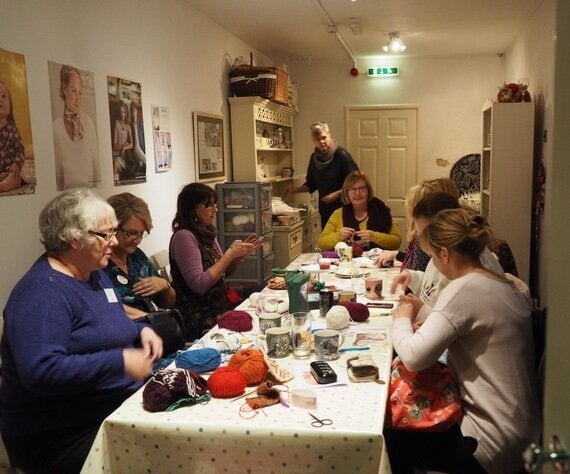One of the greatest joys of being a knitter is passing on your skills to other people, although I have to admit it took me nearly 40 years before I felt I had enough skills to teach anyone else.
For many of us it starts in a very informal way. Another knitter might ask you a question and before you know it you are showing them a tip you have picked up along the way.
Knitting groups are a great way to acquire knowledge like this. The one I belong to, The Lemsford Knitters, meet once a month in a Humphrey's Bar in Welwyn Garden City. It is a friendly and non-threatening environment. Nobody is out to score any points or ram their prowess down anyone's throats - we are all just there to enjoy ourselves. I always look forward to an evening with like-minded humans. We have had people join us with no experience and before the end of the evening they were knitting away. I have learned so much from my friends and have also been delighted to share some of my skills with them - as well as having a glass of wine and a good gossip.
If you need to brush up on a technique YouTube is just brilliant. Can't remember that fancy cast on or intricate cable stitch you were shown. I guarantee it will be on YouTube and if it isn't let me know and I will put it up for you.
Your local yarn shop is also a great place to pick up some good advice. People run yarn shops because they too love knitting or crochet so they are a great source of information ( a note on knetiquette though; if you are going to ask for lots of advice it is good manners to make sure you buy a little something as well. Yarn shops aren't libraries, they need to make a living) . The last 15 years or so has seen an increase in the number of workshops run in yarn shops. Some last just a couple of hours and some a whole weekend. You can learn basic skills or advanced techniques to take you on to the next level or a more complicated pattern, safely in the hands of an experienced teacher who can answer all your questions.
I don't teach many workshops but I do love them. Recently I have been giving just one that I think plays to my skills. I learned to knit from my German grandmother which means I am a continental knitter. Basically I hold the yarn in my left rather than right hand, so the yarn is closer to the actual direction of knitting. Some people prefer to knit this way because it is faster. But why does it matter? On the whole it doesn't, it's just a matter of personal preference or down to who taught you. But when it comes to Fair Isle or stranded knitting it opens up a whole new world of technique. Skilled Fair Isle knitters, while knitting with two colours of yarn, will hold one in each hand. It makes the knitted fabric more regular and the act of knitting faster. It's just a better way of doing things, a bit like making a meringue with a hand whisk vs. an electric whisk. For most British knitters it means having to learn to hold your yarn in the left hand or the continental way.

© Jo Shaw
So just recently I found myself at a charming yarn shop in Cleethorpes called A Good Yarn, run by the lovely Kate, ready to teach my workshop. Ten ladies joined me for a happy day of knitting. The first hour of this workshop is always difficult because I am asking my students to completely unlearn everything they have been taught but even before lunch these talented ladies had mastered the basic technique and were already on to the two-handed Fair Isle. I don't think they could quite believe it and the next few hours flew by. I use a hat pattern to teach because they can almost complete the project within the workshop, giving them a huge sense of achievement. I don't know about other teachers but I would rather cover one thing well and really embed it so that the student feels they have mastered a technique. I love to see their smiling faces as they leave.

© Jo Shaw